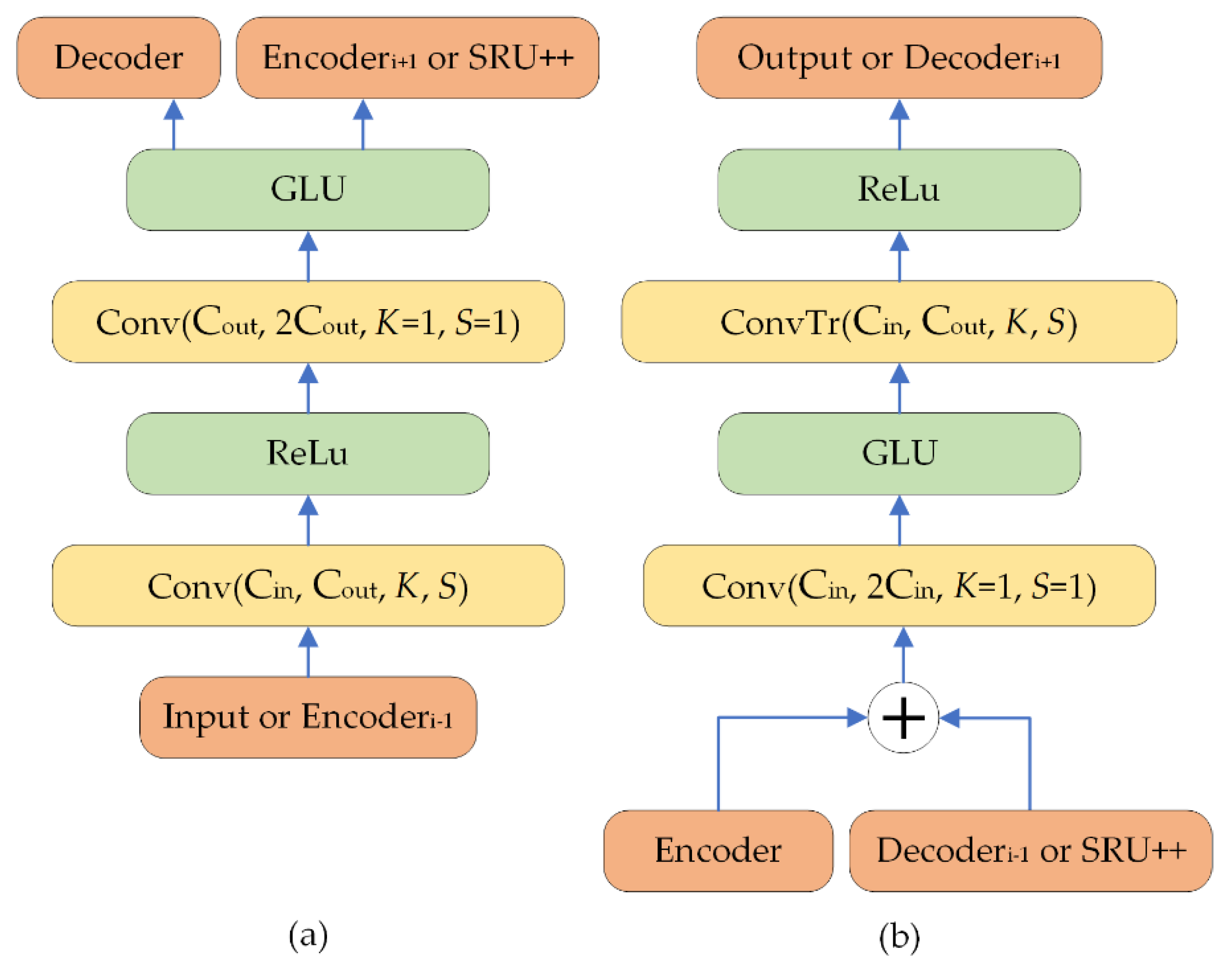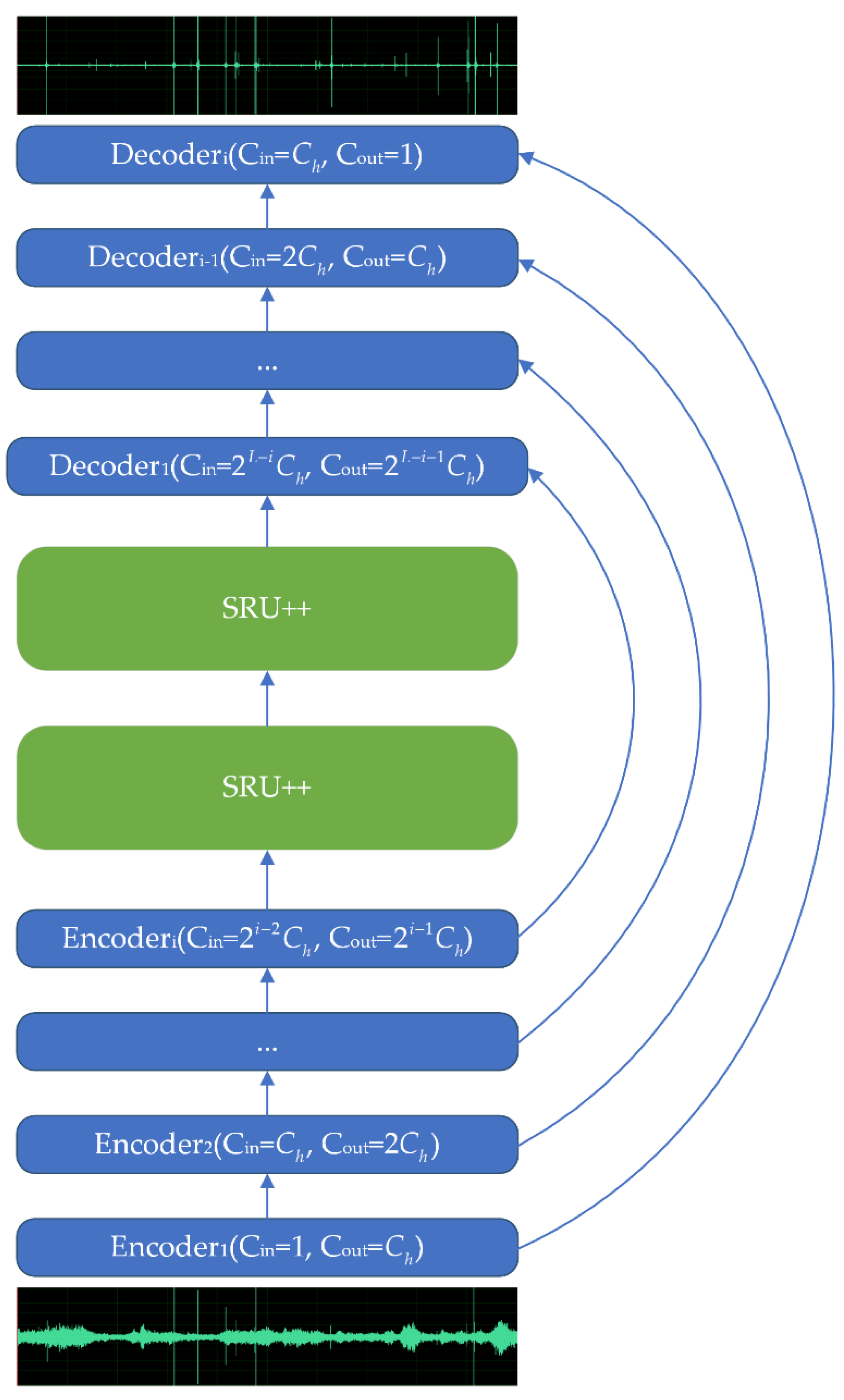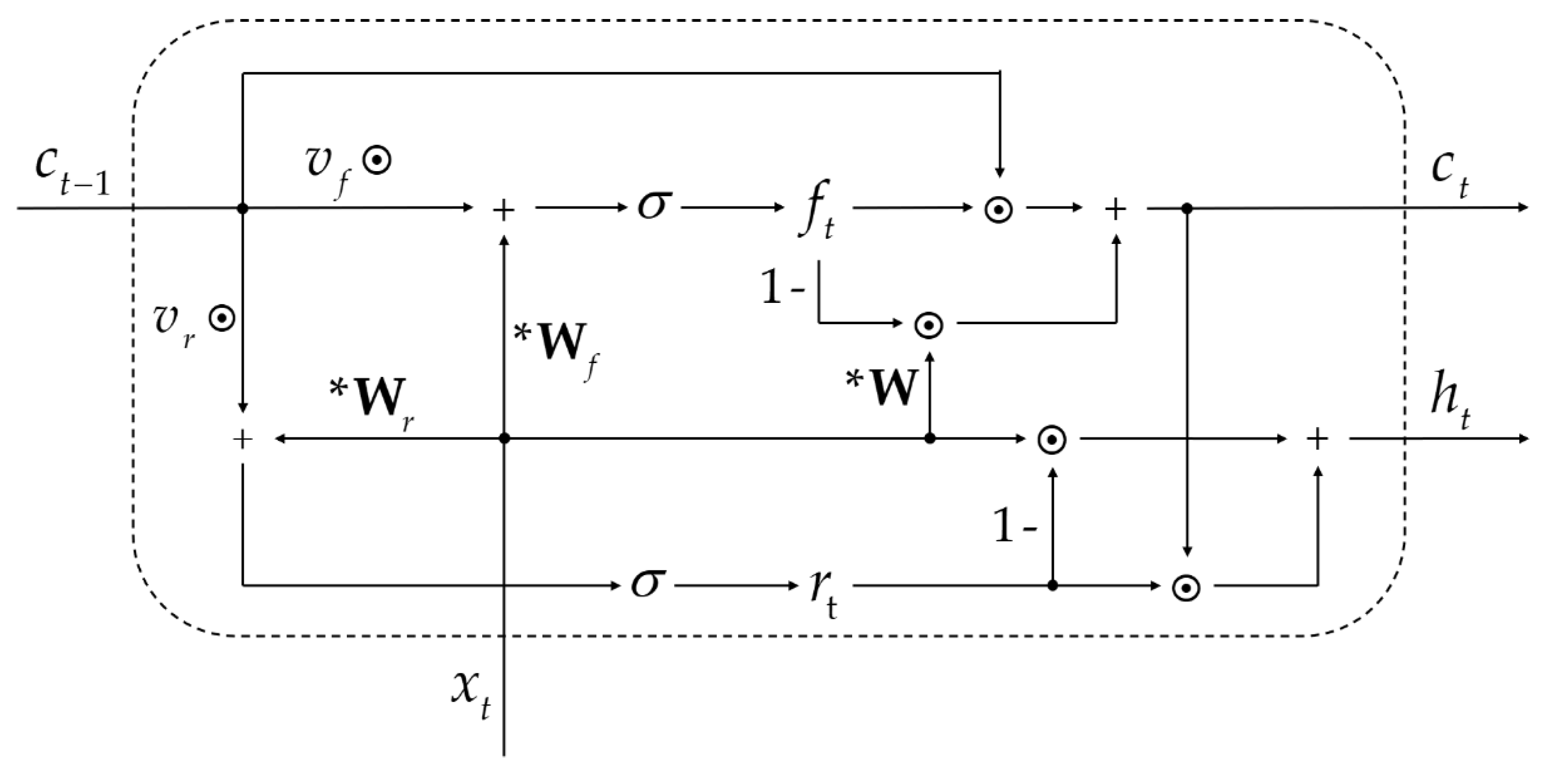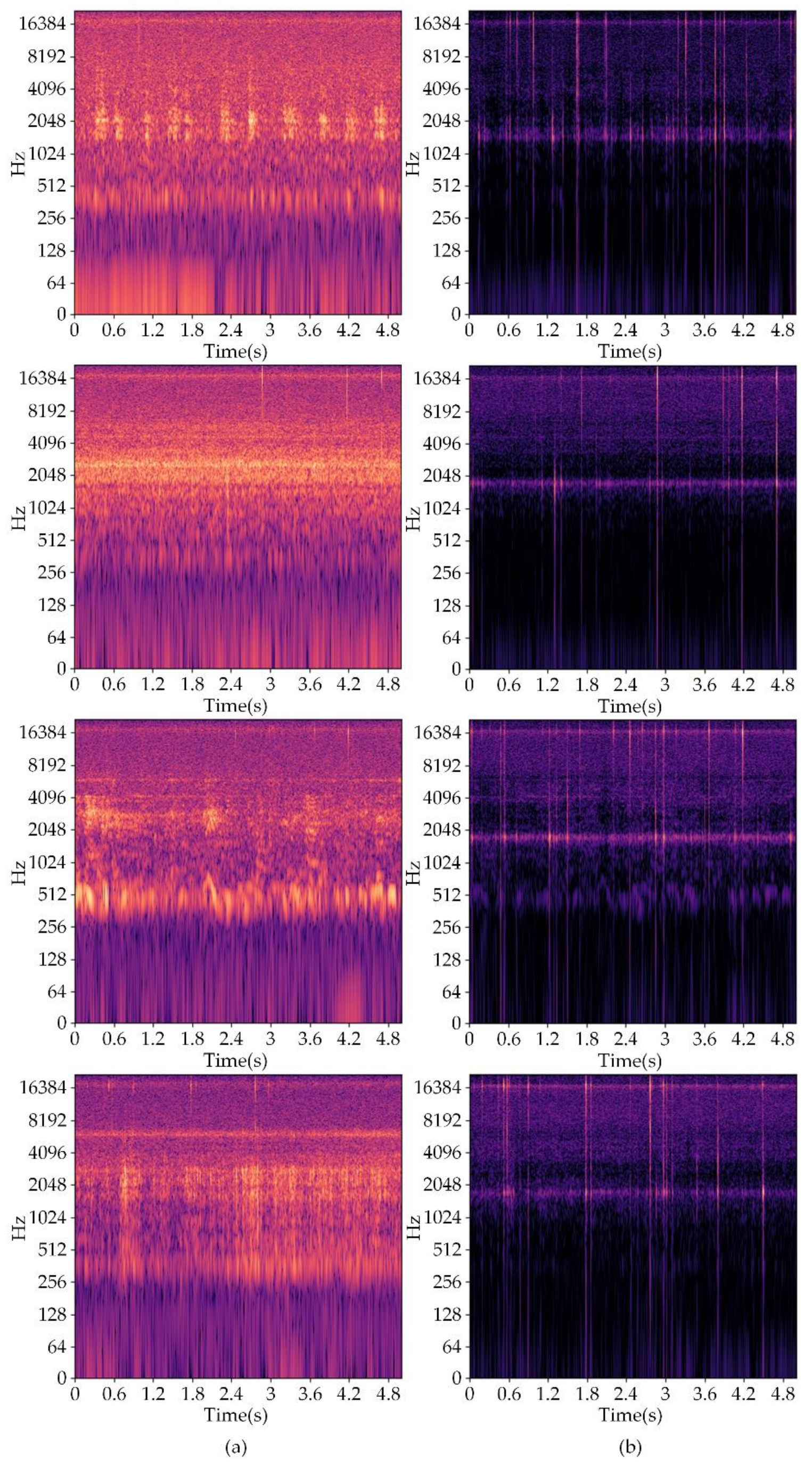A Waveform Mapping-Based Approach for Enhancement of Trunk Borers’ Vibration Signals Using Deep Learning Model
Abstract
Simple Summary
Abstract
1. Introduction
2. Materials and Methods
2.1. Dataset Preparation
2.1.1. Data Collection and Filtering
2.1.2. Dataset Production
2.2. VibDenoiser Architecture
2.2.1. Acoustic Signal Enhancement Model
2.2.2. Simple Recurrent Unit
2.2.3. Loss Function
3. Results
3.1. Experimental Settings
3.2. Evaluation Metrics
3.3. Boring Vibration Enhancement Results
3.4. Classification Results
4. Discussion
Author Contributions
Funding
Institutional Review Board Statement
Informed Consent Statement
Data Availability Statement
Conflicts of Interest
Appendix A
| Recurrent Network | SNR (dB) | SegSNR (dB) | LLR |
|---|---|---|---|
| 2-layer LSTM | 8.23 | 0.50 | 0.38 |
| 4-layer SRU++ | 8.43 | 0.62 | 0.43 |
| 6-layer SRU++ | 8.43 | 0.61 | 0.35 |
| 7-layer SRU++ | 8.43 | 0.59 | 0.34 |
| 8-layer SRU++ | 8.52 | 0.65 | 0.45 |
| 9-layer SRU++ | 8.50 | 0.67 | 0.36 |
| 10-layer SRU++ | 8.48 | 0.62 | 0.36 |
| 14-layer SRU++ | 8.43 | 0.63 | 0.37 |
| Recurrent Network | Inference Time on CPU (Second) | Inference Time on GPU (Second) |
|---|---|---|
| 2-layer LSTM | 0.9586 | 0.1107 |
| 2-layer SRU++ | 0.7635 | 0.0401 |
| 4-layer SRU++ | 0.8692 | - |
| 6-layer SRU++ | 0.9142 | - |
| 7-layer SRU++ | 0.9833 | - |
| 8-layer SRU++ | 1.0024 | 0.0404 |
| 9-layer SRU++ | 1.0468 | - |
| 10-layer SRU++ | 1.0812 | - |
| 14-layer SRU++ | 1.1628 | - |
| Recurrent Network | Model Size (MB) | Parameters | FLOPs |
|---|---|---|---|
| 2-layer LSTM | 71.98 | 18.87M | 59.47G |
| 2-layer SRU++ | 41.02 | 10.75M | 52.48G |
| 4-layer SRU++ | 46.11 | 12.07M | 53.62G |
| 6-layer SRU++ | 51.20 | 13.40M | 54.76G |
| 8-layer SRU++ | 56.82 | 14.73M | 55.90G |
| 9-layer SRU++ | 58.83 | 15.39M | 56.47G |
| 10-layer SRU++ | 61.37 | 16.05M | 57.04G |
| 14-layer SRU++ | 71.55 | 18.71M | 59.33G |
| Recurrent Network | GPU h | Batch Size |
|---|---|---|
| LSTM | 90.48 | 64 |
| 2-layer SRU++ | 77.04 | 56 |
| 4-layer SRU++ | 79.72 | 64 |
| 6-layer SRU++ | 83.08 | 64 |
| 7-layer SRU++ | 84.92 | 60 |
| 8-layer SRU++ | 86.48 | 56 |
| 9-layer SRU++ | 88.00 | 56 |
| 10-layer SRU++ | 89.80 | 56 |
| 14-layer SRU++ | 96.16 | 52 |
References
- Corley, J.C.; Jervis, M.A. Forest pest management: A global challenge. Int. J. Pest Manag. 2012, 58, 193–194. [Google Scholar] [CrossRef]
- Yan, Z.; Wei, F.; Deng, X.; Li, C.; He, Q.; Qi, Y. Does the Policy of Ecological Forest Rangers (EFRs) for the Impoverished Populations Reduce Forest Disasters?—Empirical Evidence from China. Forests 2022, 13, 80. [Google Scholar] [CrossRef]
- Herrick, N.J.; Mankin, R.W. Acoustical Detection of Early Instar Rhynchophorus ferrugineus (Coleoptera: Curculionidae) in Canary Island Date Palm, Phoenix canariensis (Arecales: Arecaceae). Fla. Entomol. 2012, 95, 983–990. [Google Scholar] [CrossRef]
- Strauß, J.; Stritih-Peljhan, N.; Nieri, R.; Virant-Doberlet, M.; Mazzoni, V. Communication by substrate-borne mechanical waves in insects: From basic to applied biotremology. Adv. Insect Physiol. 2021, 61, 189–307. [Google Scholar] [CrossRef]
- Bilski, P.; Bobiński, P.; Krajewski, A.; Witomski, P. Detection of wood boring insects’ larvae based on the acoustic signal analysis and the artificial intelligence algorithm. Arch. Acoust. 2016, 42, 61–70. [Google Scholar] [CrossRef][Green Version]
- Sutin, A.; Yakubovskiy, A.; Salloum, H.R.; Flynn, T.J.; Sedunov, N.; Nadel, H. Towards an automated acoustic detection algorithm for wood-boring beetle larvae (Coleoptera: Cerambycidae and Buprestidae). J. Econ. Entomol. 2019, 112, 1327–1336. [Google Scholar] [CrossRef]
- Zhu, L.; Zhang, Z. Automatic recognition of insect sounds using MFCC and GMM. Acta Entomol. Sin. 2012, 55, 466–471. [Google Scholar] [CrossRef]
- Luo, C.-Y.; Pearson, P.; Xu, G.; Rich, S.M. A Computer Vision-Based Approach for Tick Identification Using Deep Learning Models. Insects 2022, 13, 116. [Google Scholar] [CrossRef]
- Sun, Y.; Tuo, X.; Jiang, Q.; Zhang, H.; Chen, Z.; Zong, S.; Luo, Y. Drilling Vibration Identification Technique of Two Pest Based on Lightweight Neural Networks. Sci. Silvae Sin. 2020, 56, 100–108. [Google Scholar]
- Karar, M.E.; Reyad, O.; Abdel-Aty, A.-H.; Owyed, S.; Hassan, M.F. Intelligent IoT-Aided Early Sound Detection of Red Palm Weevils. Cmc-Comput. Mater. Contin. 2021, 69, 4095–4111. [Google Scholar] [CrossRef]
- Rigakis, I.; Potamitis, I.; Tatlas, N.-A.; Potirakis, S.M.; Ntalampiras, S. TreeVibes: Modern Tools for Global Monitoring of Trees for Borers. Smart Cities 2021, 4, 271–285. [Google Scholar] [CrossRef]
- Oberst, S.; Lai, J.C.S.; Evans, T.A. Physical Basis of Vibrational Behaviour: Channel Properties, Noise and Excitation Signal Extraction. In Biotremology: Studying Vibrational Behavior; Hill, P.S.M., Lakes-Harlan, R., Mazzoni, V., Narins, P.M., Virant-Doberlet, M., Wessel, A., Eds.; Springer International Publishing: Cham, Swizerland, 2019; pp. 53–78. [Google Scholar]
- Korinšek, G.; Tuma, T.; Virant-Doberlet, M. Automated Vibrational Signal Recognition and Playback. In Biotremology: Studying Vibrational Behavior; Hill, P.S.M., Lakes-Harlan, R., Mazzoni, V., Narins, P.M., Virant-Doberlet, M., Wessel, A., Eds.; Springer International Publishing: Cham, Swizerland, 2019; pp. 149–173. [Google Scholar]
- Mankin, R.W.; Mizrach, A.; Hetzroni, A.; Levsky, S.; Nakache, Y.; Soroker, V. Temporal and Spectral features of Sounds of wood-boring Beetle Larvae: Identifiable patterns of Activity enable improved discrimination from background noise. Fla. Entomol. 2008, 91, 241–248. [Google Scholar] [CrossRef]
- Liu, X.; Sun, Y.; Cui, J.; Jiang, Q.; Chen, Z.; Luo, Y. Early Recognition of Feeding Sound of Trunk Borers Based on Artificial Intelligence. Sci. Silvae Sin. 2021, 57, 93–101. [Google Scholar]
- Zhou, H.; He, Z.; Sun, L.; Zhang, D.; Zhou, H.; Li, X. Improved Power Normalized Cepstrum Coefficient Based on Wavelet Packet Decomposition for Trunk Borer Detection in Harsh Acoustic Environment. Appl. Sci. 2021, 11, 2236. [Google Scholar] [CrossRef]
- Potamitis, I.; Rigakis, I.; Tatlas, N.-A.; Potirakis, S. In-Vivo Vibroacoustic Surveillance of Trees in the Context of the IoT. Sensors 2019, 19, 1366. [Google Scholar] [CrossRef]
- Hu, Y.; Liu, Y.; Lv, S.; Xing, M.; Zhang, S.; Fu, Y.; Wu, J.; Zhang, B.; Xie, L. DCCRN: Deep Complex Convolution Recurrent Network for Phase-Aware Speech Enhancement. Interspeech 2020, 2472–2476. [Google Scholar]
- Pascual, S.; Bonafonte, A.; Serrà, J. SEGAN: Speech Enhancement Generative Adversarial Network. Interspeech 2017, 3642–3646. [Google Scholar]
- Cui, X.; Chen, Z.; Yin, F. Speech enhancement based on simple recurrent unit network. Appl. Acoust. 2020, 157, 107019. [Google Scholar] [CrossRef]
- Baby, D. iSEGAN: Improved Speech Enhancement Generative Adversarial Networks. arXiv 2020, arXiv:2002.08796. [Google Scholar]
- Hsieh, T.-A.; Wang, H.-M.; Lu, X.; Tsao, Y. WaveCRN: An Efficient Convolutional Recurrent Neural Network for End-to-end Speech Enhancement. IEEE Signal Processing Lett. 2020, 27, 2149–2153. [Google Scholar] [CrossRef]
- Silk, P.J.; Ryall, K.; Roscoe, L. Emerald ash borer, Agrilus planipennis (Coleoptera: Buprestidae), detection and monitoring in Canada. For. Int. J. For. Res. 2019, 93, 273–279. [Google Scholar] [CrossRef]
- Selikhovkin, A.V.; Musolin, D.L.; Popovichev, B.G.; Merkuryev, S.A.; Volkovitsh, M.G.; Vasaitis, R. Invasive Populations of the Emerald Ash Borer Agrilus planipennis Fairmaire, 1888 (Coleoptera: Buprestidae) in Saint Petersburg, Russia: A Hitchhiker? Insects 2022, 13, 191. [Google Scholar] [CrossRef] [PubMed]
- Musolin, D.L.; Kirichenko, N.I.; Karpun, N.N.; Aksenenko, E.V.; Golub, V.B.; Kerchev, I.A.; Mandelshtam, M.Y.; Vasaitis, R.; Volkovitsh, M.G.; Zhuravleva, E.N.; et al. Invasive Insect Pests of Forests and Urban Trees in Russia: Origin, Pathways, Damage, and Management. Forests 2022, 13, 521. [Google Scholar] [CrossRef]
- Lei, T. When Attention Meets Fast Recurrence: Training Language Models with Reduced Compute. In Proceedings of the 2021 Conference on Empirical Methods in Natural Language Processing, Punta Cana, Dominican Republic, November 2021; pp. 7633–7648. Available online: https://aclanthology.org/2021.emnlp-main.602.pdf (accessed on 10 January 2022).
- Simonyan, K.; Zisserman, A. Very Deep Convolutional Networks for Large-Scale Image Recognition. In Proceedings of the 3rd International Conference on Learning Representations, ICLR 2015, San Diego, CA, USA, 7–9 May 2015. [Google Scholar]
- He, K.; Zhang, X.; Ren, S.; Sun, J. Deep residual learning for image recognition. In Proceedings of the IEEE Conference on Computer Vision and Pattern Recognition, Las Vegas, NV, USA, 27–30 June 2016; pp. 770–778. [Google Scholar]
- Iandola, F.N.; Moskewicz, M.W.; Ashraf, K.; Han, S.; Dally, W.J.; Keutzer, K. SqueezeNet: AlexNet-level accuracy with 50× fewer parameters and <1 MB model size. arXiv 2016, arXiv:1602.07360. [Google Scholar]
- Sandler, M.; Howard, A.; Zhu, M.; Zhmoginov, A.; Chen, L.C. MobileNetV2: Inverted Residuals and Linear Bottlenecks. In Proceedings of the 2018 IEEE/CVF Conference on Computer Vision and Pattern Recognition, Salt Lake City, UT, USA, 18–23 June 2018; pp. 4510–4520. [Google Scholar]
- Berouti, M.; Schwartz, R.; Makhoul, J. Enhancement of speech corrupted by acoustic noise. In Proceedings of the ICASSP 79. IEEE International Conference on Acoustics, Speech, and Signal Processing, Washington, DC, USA, 2–4 April 1979; pp. 208–211. [Google Scholar]
- Jalil, M.; Butt, F.A.; Malik, A. Short-time energy, magnitude, zero crossing rate and autocorrelation measurement for discriminating voiced and unvoiced segments of speech signals. In Proceedings of the 2013 the International Conference on Technological Advances in Electrical, Electronics and Computer Engineering (TAEECE), Konya, Turkey, 9–11 May 2013; pp. 208–212. [Google Scholar]
- Tan, K.; Wang, D. A Convolutional Recurrent Neural Network for Real-Time Speech Enhancement. In Proceedings of the Interspeech, Hyderabad, India, 2–6 September 2018; pp. 3229–3233. [Google Scholar]
- Défossez, A.; Synnaeve, G.; Adi, Y. Real Time Speech Enhancement in the Waveform Domain. arXiv 2006, arXiv:2006.12847. [Google Scholar]
- Ronneberger, O.; Fischer, P.; Brox, T. U-Net: Convolutional Networks for Biomedical Image Segmentation. In Proceedings of the International Conference on Medical Image Computing and Computer-Assisted Intervention, Munich, Germany, 5–9 October 2015; pp. 234–241. [Google Scholar]
- Glorot, X.; Bordes, A.; Bengio, Y. Deep Sparse Rectifier Neural Networks. In Proceedings of the Fourteenth International Conference on Artificial Intelligence and Statistics, Proceedings of Machine Learning Research, Ft. Lauderdale, FL, USA, 11–13 April 2011; pp. 315–323. [Google Scholar]
- Dauphin, Y.N.; Fan, A.; Auli, M.; Grangier, D. Language Modeling with Gated Convolutional Networks. In Proceedings of the 34th International Conference on Machine Learning, Proceedings of Machine Learning Research, Sydney, Australia, 6–11 August 2017; pp. 933–941. [Google Scholar]
- Lei, T.; Zhang, Y.; Wang, S.I.; Dai, H.; Artzi, Y. Simple Recurrent Units for Highly Parallelizable Recurrence. In Proceedings of the Empirical Methods in Natural Language Processing, Brussels, Belgium, 31 October–4 November 2018; pp. 4470–4481. [Google Scholar]
- Zilly, J.G.; Srivastava, R.K.; Koutník, J.; Schmidhuber, J. Recurrent Highway Networks. In Proceedings of the 34th International Conference on Machine Learning, Proceedings of Machine Learning Research, Sydney, Australia, 6–11 August 2017; pp. 4189–4198. [Google Scholar]
- Vaswani, A.; Shazeer, N.; Parmar, N.; Uszkoreit, J.; Jones, L.; Gomez, A.N.; Kaiser, L.; Polosukhin, I. Attention is All you Need. Adv. Neural Inf. Process. Syst. 2017, 30. [Google Scholar]
- Abdulbaqi, J.; Gu, Y.; Chen, S.; Marsic, I. Residual Recurrent Neural Network for Speech Enhancement. In Proceedings of the ICASSP 2020–2020 IEEE International Conference on Acoustics, Speech and Signal Processing (ICASSP), Barcelona, Spain, 4–8 May 2020; pp. 6659–6663. [Google Scholar]
- Paszke, A.; Gross, S.; Massa, F.; Lerer, A.; Bradbury, J.; Chanan, G.; Killeen, T.; Lin, Z.; Gimelshein, N.; Antiga, L.; et al. PyTorch: An Imperative Style, High-Performance Deep Learning Library. In Proceedings of the NeurIPS, Vancouver, BC, Canada, 8–14 December 2019; pp. 8024–8035. [Google Scholar]
- He, K.; Zhang, X.; Ren, S.; Sun, J. Delving Deep into Rectifiers: Surpassing Human-Level Performance on ImageNet Classification. In Proceedings of the 2015 IEEE International Conference on Computer Vision (ICCV), Santiago, Chile, 7–13 December 2015; pp. 1026–1034. [Google Scholar]
- Kingma, D.P.; Ba, J. Adam: A Method for Stochastic Optimization. In Proceedings of the ICLR, San Diego, CA, USA, 7–9 May 2015. [Google Scholar]
- Loizou, P.C. Speech Quality Assessment. In Multimedia Analysis, Processing and Communications; Lin, W., Tao, D., Kacprzyk, J., Li, Z., Izquierdo, E., Wang, H., Eds.; Springer: Berlin/Heidelberg, Germany, 2011; pp. 623–654. [Google Scholar]
- Musolin, D.L.; Selikhovkin, A.V.; Shabunin, D.A.; Zviagintsev, V.B.; Baranchikov, Y.N. Between ash dieback and emerald ash borer: Two Asian invaders in Russia and the future of ash in Europe. Balt. For. 2017, 23, 316–333. [Google Scholar]
- Herms, D.A.; McCullough, D.G.; Smitley, D.R.; Sadof, C.S.; Williamson, R.C.; Nixon, P.L. Insecticide options for protecting ash trees from emerald ash borer. North Cent. IPM Cent. Bull. 2009, 12. Available online: https://store.extension.iastate.edu/product/Insecticide-Options-for-Protecting-Ash-Trees-from-Emerald-Ash-Borer (accessed on 22 June 2022).




| Recurrent Network | SNR (dB) | SegSNR (dB) | LLR |
|---|---|---|---|
| 2-layer LSTM | 8.23 | 0.50 | 0.38 |
| 4-layer SRU++ | 8.43 | 0.62 | 0.43 |
| 8-layer SRU++ | 8.52 | 0.65 | 0.45 |
| 14-layer SRU++ | 8.43 | 0.63 | 0.37 |
| Loss Function | SNR (dB) | SegSNR (dB) | LLR |
|---|---|---|---|
| L1 | 8.62 | 0.70 | 0.40 |
| L2 | 8.59 | 0.65 | 0.36 |
| Huber | 8.54 | 0.67 | 0.36 |
| L1 + STFT | 6.61 | −1.38 | 0.11 |
| L1 + SNR | 7.56 | 0.43 | 10.48 |
| log-cosh | 8.65 | 0.71 | 0.40 |
| Recurrent Network | Loss Function | SNR (dB) | SegSNR (dB) | LLR |
|---|---|---|---|---|
| 2-layer SRU++ | L1 | 8.49 | 0.65 | 0.31 |
| 2-layer SRU++ | log-cosh | 8.57 | 0.66 | 0.33 |
| 4-layer SRU++ | log-cosh | 8.55 | 0.68 | 0.37 |
| Recurrent Network | GPU h |
|---|---|
| 2-layer LSTM | 90.48 |
| 2-layer SRUPP | 77.04 |
| 8-layer SRUPP | 86.48 |
| Classification Model | Accuracy on Noisy Test Set | Accuracy on Enhanced Test Set |
|---|---|---|
| VGG16 | 81.14% | 92.51% |
| ResNet18 | 89.39% | 96.47% |
| SqueezeNet | 78.45% | 88.89% |
| MobileNetV2 | 85.77% | 90.40% |
Publisher’s Note: MDPI stays neutral with regard to jurisdictional claims in published maps and institutional affiliations. |
© 2022 by the authors. Licensee MDPI, Basel, Switzerland. This article is an open access article distributed under the terms and conditions of the Creative Commons Attribution (CC BY) license (https://creativecommons.org/licenses/by/4.0/).
Share and Cite
Shi, H.; Chen, Z.; Zhang, H.; Li, J.; Liu, X.; Ren, L.; Luo, Y. A Waveform Mapping-Based Approach for Enhancement of Trunk Borers’ Vibration Signals Using Deep Learning Model. Insects 2022, 13, 596. https://doi.org/10.3390/insects13070596
Shi H, Chen Z, Zhang H, Li J, Liu X, Ren L, Luo Y. A Waveform Mapping-Based Approach for Enhancement of Trunk Borers’ Vibration Signals Using Deep Learning Model. Insects. 2022; 13(7):596. https://doi.org/10.3390/insects13070596
Chicago/Turabian StyleShi, Haopeng, Zhibo Chen, Haiyan Zhang, Juhu Li, Xuanxin Liu, Lili Ren, and Youqing Luo. 2022. "A Waveform Mapping-Based Approach for Enhancement of Trunk Borers’ Vibration Signals Using Deep Learning Model" Insects 13, no. 7: 596. https://doi.org/10.3390/insects13070596
APA StyleShi, H., Chen, Z., Zhang, H., Li, J., Liu, X., Ren, L., & Luo, Y. (2022). A Waveform Mapping-Based Approach for Enhancement of Trunk Borers’ Vibration Signals Using Deep Learning Model. Insects, 13(7), 596. https://doi.org/10.3390/insects13070596







